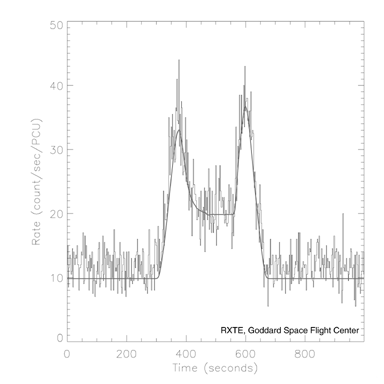|
|
The Universe Lights Up on Beethoven's Birthday
RXTE Pinpoints Location of Gamma Ray Burst
What RXTE Saw of the Beethoven Gamma Ray Burst

Figure 1 -- Now you see it; now you don't; now you see it again. At
370 seconds into its zigzag search, RXTE spots the gamma-ray burst.
RXTE cannot stop so quickly, though. The scan continues. At 600
seconds, during the "zag" of the zigzag search, RXTE gets another
good look at the burst. By 700 seconds, RXTE is pointing in
another direction and can no longer detect anything.

Figure 2 -- RXTE on the prowl: After receiving information from
the Compton Gamma Ray Observatory about the approximate location of
the Beethoven gamma-ray burst, RXTE scanned the sky toward that
direction in a zigzag fashion. The line shows the path of RXTE's scan
(RXTE rotates its instruments; it doesn't travel to the source.) The
numbers embedded in the line indicate time -- the amount of seconds,
in hundreds, that passed during the scan. The large dotted circle is
the size of RXTE's field of view. The smaller circle is an
approximation of the burst source. (The original location estimate is
larger than this entire image). At 600 seconds, we see the RXTE field
of view nearly centered on the burst source.
|
